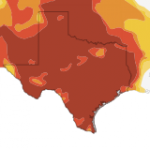Taking a Closer Look at the Drought’s Toll on Trees

Photo by Flickr user GrungeTextures/Creative Commons
The Texas drought has killed an estimated 5.6 million urban trees and 500 million forest trees, roughly 10 percent of the trees in Texas.
The Texas Forest Service plans to take a long look at Texas’ trees to see how much damage the ongoing drought has done.
Last December, the forest service released a preliminary estimate of between 100 and 500 million trees killed by the drought. A later estimate of tree losses in urban areas of Texas have been pegged at more than five million. Both of those surveys relied on satellite imagery of trees in Texas.
But now the Forest Service is taking a closer look.
Chris Brown of the Texas Forest Service says the new survey is phase two of an overall study on the drought’s impact on trees. “Drought affected all of Texas last year,” Brown says, “but there are regional variations. Some areas were hit harder than others and we’d like to try and identify those so we can help those landowners recover their forests.”
The survey will help find more accurate numbers of loss by gathering physical measurements from 700 plots of land chosen from those satellite images. The forest service hopes that these data will help narrow down the earlier estimates. “One hundred to five hundred million is a very broad range,” Brown says, “so we are trying to narrow that down and get a more accurate number by installing plots and doing a physical sampling of the rural trees.”
And they’re reaching out to private landowners for help. Since almost ninety-five percent of land is owned by private individuals or companies, coordination among forest service personnel and land owners is critical. The service plans to contact individual landowners by phone or email and request permission to access their property to set up measurements.
On each plot of land, the service will examine a 75-foot radial section of trees. The service says they will also be collecting information to look at the impact of bark beetles and hypoxylon canker.
Data from the survey will help communities identify which tree species have suffered the most damage. The service hopes this will lead to better planning for reforestation.
A third phase will take place later, which the forest service says is “more scientific” and “longer-term.” That’s part of what it refers to as a census for trees, the federally-funded Forest Inventory & Analysis program. The service says the new survey will take about two months.



